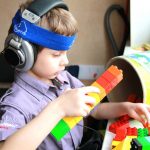For the next 4-5 blogs we will focus on different aspects of acquiring reading skill. Reading is an acquired skill in the brain and not something that we are born with. It comprises of the ability to decode symbols of information as well as comprehending the words with meaning to make sense of what we are reading. Decoding is the “technical” part of reading and is comprised of the following aspects:
- The ability to see a string of letters from left to right in a sequential order requiring visual skill.
- The ability of the auditory system to be able to sound out what the eyes are seeing (phonics).
- The ability of the visual and auditory system to time together in split second second timing to gain automaticity, speed and reading fluency.
All three components are developed in the brain during early development, first requiring each system’s separate development and then ultimately the systems have to integrate together. Decoding can impact on reading efficiency in different ways:
- Some persons clearly struggle with decoding and it is an obvious difficulty that is witnessed by the observer.
- Other persons would appear to decode fine, especially when reading story books of their interest, but struggle greatly when it comes to factual text books, finding themselves reading the same text over and over.
- Others would be able to decode sufficiently, supporting the process with their intelligence, but would never be seen to pick up a book to read for pleasure.
Many families will note to us that their child can decode very well, but cannot comprehend what they are reading. If their listening comprehension is intact and they have sufficient command over language in other contexts, it does not make sense that it would only be in reading that they could not comprehend. We have to consider more closely what the different components of decoding skill are and assess each separate function in order to determine why reading has such an impact on a person’s learning ability, especially when intelligence is intact. For this writing let us briefly focus on the different visual skills involved in the reading decoding process.
In order for the eyes to see the letters it is supposed to decode, we require acuity and ocular motor skill. Acuity is tested through an optometrist, though ocular motor skills frequently are not. There are ciliar muscles around the eyes that have to be synchronized in order to create this efficiency. The eyes have to work together to see exactly at the same point on the page (binocular fusion). Both eyes have to be able to rapidly move from one point to another very quickly (saccades). And both eyes have to be able to fixate together at the end of a saccadic eye movement in order to give the auditory system time to sound out what was seen.
Decoding also requires a very precise synchrony between the visual and vestibular system in order to gain efficiency. The development of the Vestibulo-Occular Reflex (VOR) is an important piece of development in this instance. We have to be able to intricately coordinate the visual pathway of stable vision with peripheral vision in order to affect the momentum of the eyes. Some persons with reading difficulties will note that for them it feels like the words are moving and they need to “catch up” to the individual words. The eyes also need to develop visual perceptual skills such as:
- Form Constancy – no matter the font, it will be recognized for the letter it is. Visual discrimination will assist in seeing the differences in each letter to be able to read it.
- Visual Figure ground is an ability to pay attention to the foreground (letters in black) against the background (the white page). For some persons it feels like they are seeing white “rivers” instead of focusing on the black print. When a reader is fluent in decoding they also employ Visual Closure. This is seen in the ability of the brain to “close” the letters we are scanning through on a written page. Fluent readers do not look at each letter anymore.
- Visual memory is required to remember different letters, words, and patterns to form Word Attack skills.
Another skill would be Visual Sequential Memory that recognizes the different sequences in words in a certain order. Some persons are observed to reverse letters, sounds and words and have to “de-reverse” in order to make sense of a word. We will discuss this more under laterality later.
Each of these skills need to be assessed on it’s own in order to determine efficiency. These areas can be influenced by therapy and need to be considered when confronted by a struggling reader. There is no reason anyone, no matter the age, can learn to read as it is an acquired developmental skill, not a specific brain injury. Decoding training requires skill and expertise and is not going to be changed if we are simply taking someone in a separate room to read “at their own pace”. In the next blog we will discuss the involvement of the auditory system.








